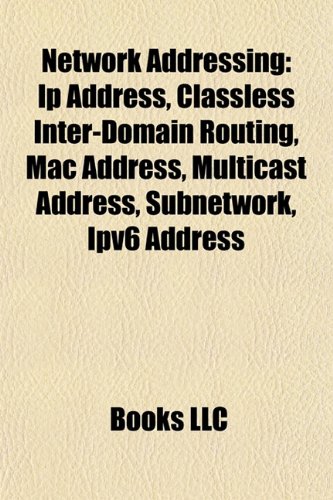Items related to Network addressing: IP address, Classless Inter-Domain...
Network addressing: IP address, Classless Inter-Domain Routing, MAC address, Multicast address, Subnetwork, IPv6 address - Softcover

Reseña del editor:
Please note that the content of this book primarily consists of articles available from Wikipedia or other free sources online. Pages: 40. Chapters: IP address, Classless Inter-Domain Routing, MAC address, Multicast address, Subnetwork, IPv6 address, IPv4 address exhaustion, Organizationally unique identifier, List of assigned /8 IPv4 address blocks, Barefruit, Private network, IPv4 subnetting reference, Typosquatting, Geo, Solicited-node multicast address, Getaddrinfo, Link-local address, Broadcast address, Unique user, IPv6 subnetting reference, Dot-decimal notation, Individual Address Block, CIDR notation, E.123, Circuit ID, Care-of address, IEEE Registration Authority, Provider-independent address space, Naming scheme, Wildcard mask, RealNames, MAC filtering, Host address, Internet number, Virtual IP address, NSEL, Provider-aggregatable address space, Geospacial Internet. Excerpt: An Internet Protocol Version 6 address (IPv6 address) is a numerical label that is used to identify a network interface of a computer or other network node participating in an IPv6-enabled computer network. IP addresses serve the purpose of uniquely identifying the individual network interface(s) of a host, locating it on the network, and thus permitting the routing of IP packets between hosts. For routing, IP addresses are present in fields of the packet header where they indicate source and destination of the packet. IPv6 is the successor to the Internet's first addressing infrastructure, Internet Protocol version 4 (IPv4). In contrast to IPv4, which defined an IP address as a 32-bit number, IPv6 addresses have a size of 128 bits, vastly expanding the addressing capability of the Internet Protocol. Decomposition of an IPv6 address into its binary form. IPv6 addresses are classified by the primary addressing and routing methodologies common in networking: unicast addressing, anycast addressing, and multicast addressing. IPv6 does not implement broadcast addressing. Broadcast's tra...
"About this title" may belong to another edition of this title.
- PublisherBooks LLC, Wiki Series
- Publication date2011
- ISBN 10 1156546265
- ISBN 13 9781156546260
- BindingTapa blanda
- Number of pages42
(No Available Copies)
Search Books: Create a WantIf you know the book but cannot find it on AbeBooks, we can automatically search for it on your behalf as new inventory is added. If it is added to AbeBooks by one of our member booksellers, we will notify you!
Create a Want